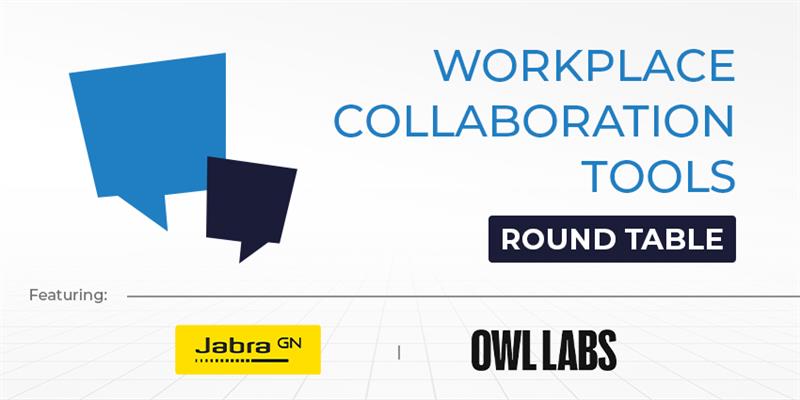As hybrid and remote work models continue to evolve, organisations are increasingly relying on digital collaboration tools to streamline communication, enhance project management, and foster seamless teamwork across locations.
From real-time messaging and video conferencing to task automation and document sharing, these tools empower teams to work smarter and more efficiently. But with a vast array of options available, choosing the right platform can be daunting.
With our latest Round Table subject, “Workplace Collaboration Tools”, we spoke with experts and executives from Jabra and Owl Labs about the emerging trends and technologies shaping workplace collab tools, how AI is impacting collaboration platforms, the key challenges collaboration tools need to address to better support hybrid or remote work models, and the importance of user experience in driving adoption of collaboration tools.
What emerging trends or technologies are currently shaping the development of workplace collaboration tools?

Nigel Dunn, MD and VP at Jabra
Dunn highlighted Jabra’s research, which noted that 80 percent of decision-makers are willing to delegate or collaborate on tasks with AI, resulting in a growing use of generative AI to enhance workplace productivity.
“This use of AI as a virtual colleague is set to grow in 2025 as tools continue to streamline and automate workflows, enabling organisations to operate with maximum efficiency,” Dunn said.
“Microsoft Copilot, for instance, is already proving to be an invaluable assistant for virtual meetings, transcribing in real-time, generating detailed summaries, and creating actionable tasks for participants. Jabra expects increased adoption of such assistive tools, as there is a clear appetite for efficiency-boosting technology, with 84 percent of leaders expressing high trust in these advancements.”
Frank Weishaupt, CEO of Owl Labs
Weishaupt observes that while hybrid work is far from a new phenomenon, organisations of all sizes have been experimenting with new ways of working in recent years.
“For example, Owl Labs’ State of Hybrid Work report found that 51 percent of UK employees were working in a hybrid model in 2024, which marks a 5 percent increase from 2023 (46 percent),” Weishaupt explained. “This shift has required organisations to rethink their approach to workplace collaboration, ensuring that distributed teams can work together seamlessly.”
Equally, Weishaupt highlighted the increase in AI use in the workplace has raised employee expectations regarding workplace collaboration tools. 68 percent of UK workers now use AI to do their jobs, yet nearly one-third (33 percent) of UK businesses are not promoting AI use among their workforce.
“While non-technical staff may not understand all the specifics of how AI works, they understand its potential,” Weishaupt said. “Workplace collaboration tools have therefore had to follow suit, integrating AI where relevant to deliver better experiences for all employees, whether working remotely or in office.”
How is artificial intelligence transforming collaboration platforms, and where do you see its biggest impact in the next 3-5 years?

Frank Weishaupt, CEO of Owl Labs
Weishaupt emphasised that the expanding use of AI in everyday work has encouraged collaboration platforms to improve the security and efficacy of their systems.
“This means obtaining the appropriate certifications for any AI-enabled software or hardware, as well as ensuring that such tools provide enterprise-ready capabilities to deliver maximum results,” he outlined.
“The next few years will be all about training employees to work alongside AI so that they can use these tools confidently and productively. There will also be a strong focus on using AI responsibly, balancing cost savings with ethical practices to keep trust high.”
Nigel Dunn, MD and VP at Jabra
Dunn suggested how we interact with Gen AI tools will be key to unlocking their full potential in the workplace.
“No longer will employees simply sit in front of a computer,” Dunn expanded. “In 2025, we’ll see more natural, human-like interactions with the software and applications we use to complete our tasks every day. This means more effortless communication with computers, software, and data using just our voices.”
Dunn also flagged that there is a growing interest in voice-powered technology, with more than a third (36 percent) of leaders wanting to use their voice-over written prompts to communicate with AI. This preference will only become more widespread since voice interactions with AI can boost productivity by drastically reducing the time spent on routine activities.
“By using voice commands, information can be conveyed up to five times faster than typing,” Dunn continued. “AI-driven voice technology can record in-person client conversations and automatically generate meeting summaries, so in 2025, expect manual notetaking to become obsolete.”
Five years after the pandemic, what are the key challenges collaboration tools need to address to better support hybrid or remote work models in 2025?
Frank Weishaupt, CEO of Owl Labs
Weishaupt underlined that 83 percent of UK workers believe that having access to good technology is essential to their working life. Yet, only 20 percent of companies upgraded their video conferencing technology in 2024.
“These stats highlight a clear gap between employee expectations and what organisations are delivering, meaning that 2025 requires a continued focus on upgrading meeting technology to deliver better hybrid meeting experiences,” Weishaupt explained.
“This includes adopting hybrid-ready tools, such as video conferencing cameras, which create equitable meeting experiences with high-quality video, AI-driven tracking, and smart sound systems. By investing in such technology, companies can create adaptable, immersive meeting environments that cater to the unique needs of hybrid teams, fostering productivity and cohesive communication across locations.”
How important is user experience in driving adoption of collaboration tools, and what do companies often overlook in this area?
Frank Weishaupt, CEO of Owl Labs
For Weishaupt, many companies are still restrained by the idea of collaborating within a traditional fixed conference room setup. Not only does this not match the distributed reality of modern office environments, he added, but it fails to deliver a strong user experience for both remote and in-person participants.
“For instance, UK businesses are experiencing significant challenges with hybrid meetings, including time lost to technical difficulties (75 percent), audio problems (73 percent), and visual communication barriers (72 percent) persisting,” Weishaupt said.
He stressed that providing the best possible user experience for all employees is about offering flexibility and versatility:
“When it comes to collaboration tools, this includes designing meetings with hybrid participants in mind rather than relying on in-person interactions. This can include using tools like 360-degree cameras to ensure that all participants feel as though they are in the room, even when joining remotely. Getting the foundations right is key, as seamless collaboration always starts with an inclusive user experience.”







